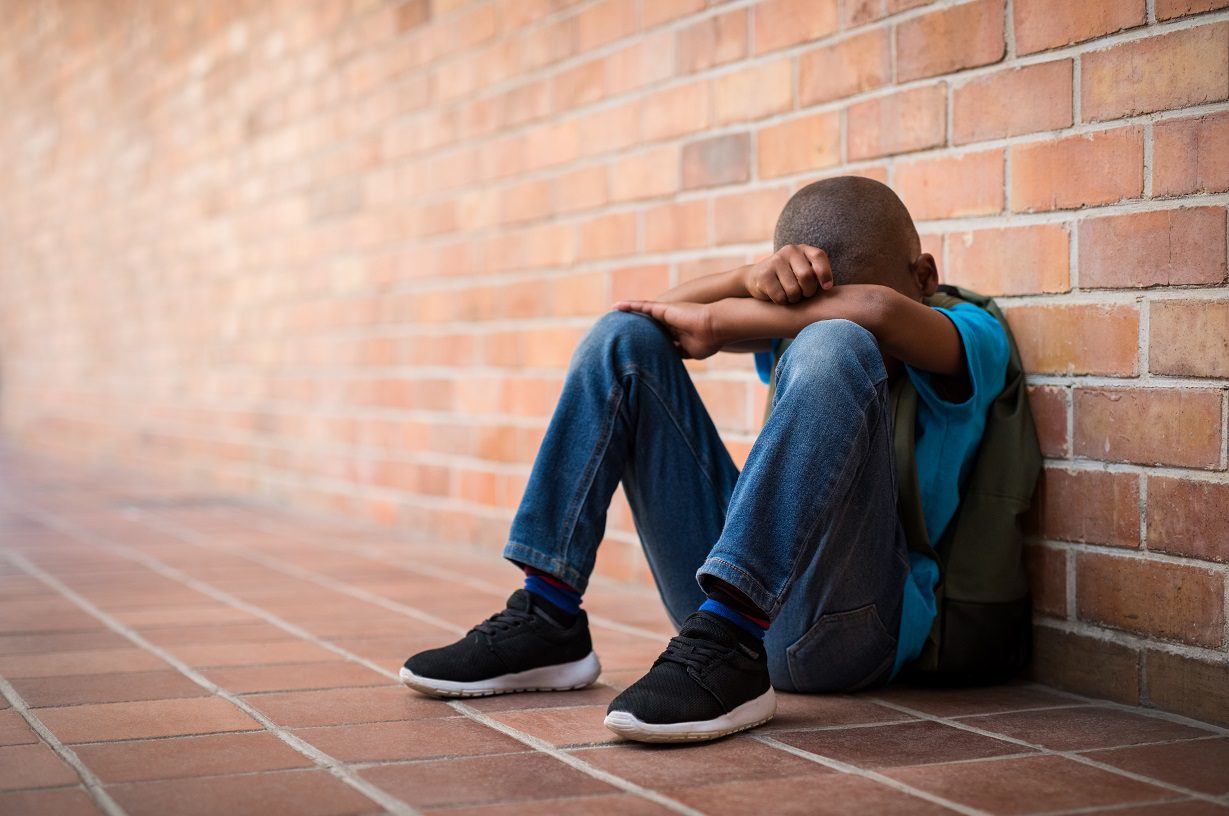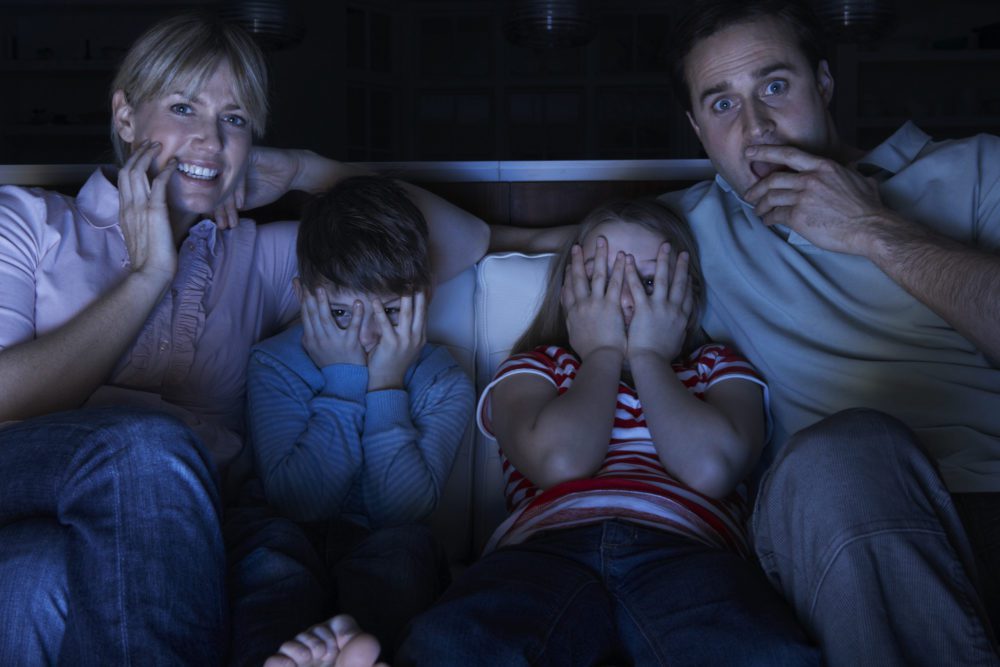Fear of the Dark? 16 Ways to Help Your Child

Posted in: Parenting Concerns
Topics: Anxiety
Halloween is almost here, and its presence is inescapable – from commercials and scary movies on TV to ghosts, goblins, and menacing figures in neighbors’ yards. And while it is an exciting and highly anticipated time for many kids, some look upon it with dread.
Though the technical fear of Halloween, Samhainphobia, is not listed as a disorder our clinical diagnostic manuals, it is simply terrifying for many. It is associated with other fears, such as spiders, clowns, skeletons, zombies, death, getting startled, being chased, approaching strange houses for “tricks” (that’s super scary for many) or treats. It is also associated with fear of the dark.
I want to focus on fear of the dark, not just in its association with Halloween but also as a bone fide phobia (Nyctophobia), and consider what we can do as parents and caregivers to help our kids overcome this very common fear.
Fear of the dark is one of the most common fears among children, and in most cases is a normal growth-related process in kids 3 to 6 years old. In fact, most developmental psychologists and child and adolescent psychiatrists would say it is a normal phase of development. It is hard to determine the vast nature of this fear. For example, in a study of Dutch children over 73% of children aged 4-12 said they had fears at night. It is not clear from this and other studies whether this is fear of the dark itself or other fears they associate with the dark. There have been some studies in trying to understand just how common it is, but most studies couple “fears” of the dark together with a “phobia” of the dark.
There is a big difference between a normal childhood fear, even if it merits parental intervention, and a specific phobia. A phobia is different that a fear in that it includes:
- Specific phobias are among the most common psychiatric disorders (12% among adults at any time in their life, and almost 20% of teens)
- A phobia involves uncontrollable and severe feelings of panic and anxiety.
- They typically involve panic attacks, that may include: rapid heart rate (palpitations); hyperventilation; dizziness; nausea; shakiness; feelings of terror and impending doom; fainting; dizziness.
- Intentional avoidance of the object of fear. In this case, refusal to go to bed.
- The main difference is the degree of anxiety involved. In phobias, it is quite extreme.
Why Fear of the Dark is Normal
Fear is a normal response to danger. Between ages 3-6, all children come to realize there is an external world that might be dangerous. Prior to this, they felt connected to their parents and did not realize in some deep way, that the external world could be dangerous place. They are beginning to learn that there are things that can hurt them, and:
- They do not have a clear sense of time, so going to bed may make them unsure when they will see their parents again.
- They have developed a keen imagination, but they have not fully distinguished the difference between reality and fantasy (imagination), so monsters, things that go bump in the night, burglars and more all have a threating reality, and being alone and separated from the caregivers they have long depended on to protect them, are gone after they are put to bed.
- They are too young to control and regulate their own emotions by themselves, and when put to bed, filled with fears, anxieties, and the darkness that does not allow for distractions in the light of day, all lend to their emotions running wild.
Most kids begin to develop the capacities noted above starting at age 6. This is why much of the fear of the dark goes away as they mature.
When these normal fears significantly interfere with their life, they become phobias.
What Parents Can Do to Help
- Understand Your Child’s Fears. While you should not force your child to talk about their fears, you can ask open ended questions like, “What are you afraid of when you go to bed?” or “What scares you in the dark?” These questions should be raised at different times, such as during the day when they are not fearful. You will know more about what techniques will help alleviate fears if you know what their fears are. Once you know, you can provide appropriate support, reassurance, or let them know, “Monsters are not real, so you don’t have to worry.” Most kids are not afraid of monsters, burglars, or other creatures during the daytime, and this may be a great time to allay their fears. These statements, once iterated during the day, can be re-stated at bedtime when the child is experiencing fear.
- Use Stories and Cognitive Behavior Therapy (CBT). CBT, coupled with comforting stories and talking in a graduated way about fear of the dark, has proven to be an effective technique in helping kids tackle fear of the dark. Find a book that has a story about bedtime; develop ways to gradually elicit your child’s fears; use progressive exposure to more stressful situations in the book; make it playful, and correct exaggerated thoughts. It is fun, creative, and helpful.
- Encourage Creative Arts to Help Your Kids Express Their Feelings. Many kids can draw, build Lego® structures, tell or act out stories about their nighttime fears. Creative processes and PLAY help them work out their anxieties.
- Listen to Your Child and Validate Their Feelings. Feelings are real and should be acknowledged even if they are afraid of monsters under their bed. You can then gently let them know they really do not exist.
- Help Your Child See Bed as a Safe Space. Sitting with them at bedtime, role playing during the day, or even helping them see that their bed is comfortable and safe if they take a daytime nap, helps them view their bed as a comforting and safe space.
- Use Night Lights. This is probably one of the most important techniques. It really helps for them to have some warm, comforting light.
- Use Transitional Objects. A comfy blanket, stuffed animal or other cuddly object can help your kids soothe themselves when alone and particularly when going to bed.
- Have Consistent Bedtime Routines. Rituals at bedtime, taking a bath, putting on their pajamas, reading a story, saying prayers, sitting next to them, and providing rituals of your choice will provide a comforting, expected routine that sends a message that the world is an expectable place. Kids love structure!
- Use Books and Movies About Nighttime Fears. We know Nightmare in my Closet and other books that address fears of the dark. I would use them. There are also videos, such as Goodnight Moon and Other Sleepytime Tales (an HBO family special).
- Use Music. Many kids love the soothing music, white noise or nature sounds in their room. You might consider making a playlist that you play during that day and use that to dance, sing, and enjoy together. Then when they go to bed, putting on the same playlist they associate with your presence and having fun is often helpful in calming them down.
- Beware of What Your Kids See on TV. Media, TV shows, commercials, local news, even cartoons and more can be very disturbing to young kids, because they see them as real and carry their fears to bed with them. Young children should have media monitored and for the most part turned off unless you know that content of a video.
- Beware of Scary Stories and Books. Grimm’s Fairy tales, and many other stories, may be terrifying to kids – even Dr. Seuss stories! You don’t know what scares them, but it is always important to find out and put these stories and books aside.
- Practice Role Playing During the Day. You can play going to sleep games, in which you are the child, and they are the parent or the other way around, during the light of day, to creatively practice going to sleep. This is fun, is creative, and is done during a time of day with plenty of light. It builds self-confidence and techniques you can practice during the day, then repeat them at night. Use praise and reassurance as they develop the ability to go to sleep alone.
- Show Your Child How To Relax. We all need ways to comfort ourselves. Meditation, Yoga and breathing exercises can be done during the day, sometimes with the whole family to teach them techniques of self-care, self-soothing, and relaxation they can use in bed. Ask them what soothes them the most. Whatever technique you use, do it with them, so they associate it with your helping them relax. This can be repeated at nap and bedtime.
- Consider Sources of Stress Unrelated to Sleep. Some kids take stresses such as family conflict, problems at school, sibling fights and any other sources of anxiety with them to bed. While the fear of the dark may seem to be the real problem it may be an expression of anxieties kids take to bed with them. You should ask in your conversations if there are other things besides going to bed that they worry about.
- Control Your Own Frustration. Having a child that is fearful, crying, suffering, and demanding is not easy on you. If you cannot control your own anger, irritation, your child will pick up on this, and take it as lack of approval, as indicating you are mad with them, that they feel guilty that they are upsetting you, and all this will increase the problem of their settling down. Try to be patient, and if you have a partner or older sibling at home, use someone else your child is close to in order to soothe them and give yourself a break.
If your child does not respond to the many strategies above, get a mental health evaluation. About 1 in 10 kids with a fear of the dark will have an underlying anxiety disorder. Other psychiatric disorders that impair an ability to self-soothe, include depression, Attention Deficit Disorder, learning disorders, trauma (either at home, in school or in the community). If conflicts in the family are extremely disturbing, it may be valuable to reach out to your pediatrician about a mental health evaluation. This should be a comprehensive clinical evaluation for your child and the family. There may be need for psychological testing as well.
Fears of the dark, even Nyctophobia, can be alleviated and most of us enjoy being enveloped and comforted by darkness and the peace it brings.

 Share
Share Tweet
Tweet





